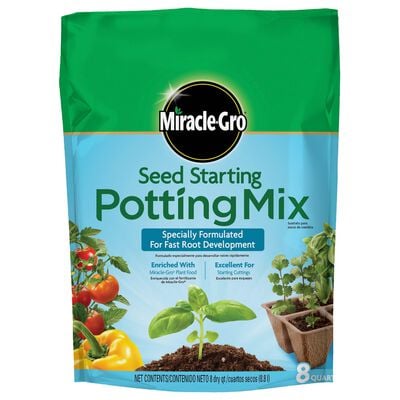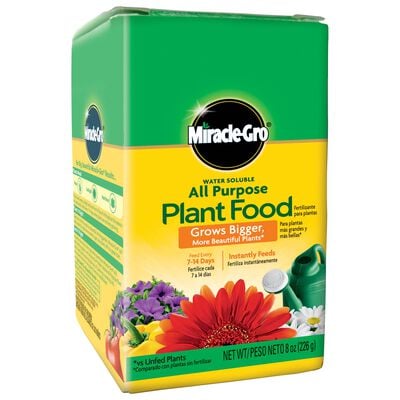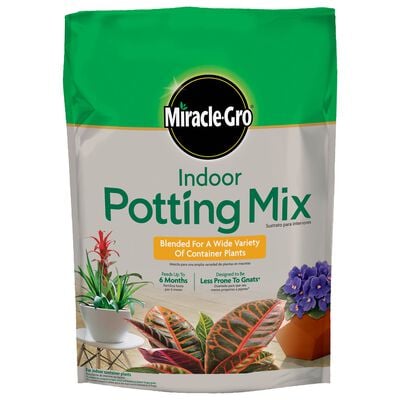
Starting Seeds Indoors
It's "sow" much fun!
Whether you're looking to diversify your garden or just ready to expand your skills, growing a plant from seed to harvest is a rewarding challenge that can be easily achieved. Really! And if you begin indoors, you can jumpstart the season while ensuring they have the best possible growing conditions. Follow these steps to start them off right.
Time it Right
One of the benefits of starting seeds indoors is that you can sneak in a longer season. This is fulfilling for eager gardeners but also ideal for certain plants that need an extended growing period to reach their full potential.
There is a sweet spot, however. If you begin too early your seeds may outgrow their starter containers before you're able to transplant them into an outdoor garden or larger pots inside. Most can be sown indoors around 6 weeks before spring sees its final frost, depending on your plant hardiness zone and the variety. Keep in mind that not all seeds are suited to indoor growing, no matter when you start. Check the information that comes on the back of the packet or with the breeder you buy them from to know how your region matches up with your seed's needs.
Choose Quality Seeds
Because you're doing the (satisfying!) work instead of a nursery, seeds are less expensive than starter plants. This makes it easy to invest in high-quality seeds from a reputable source or brand, such as Bonnie Plants. Choose from their range of Seed Starting Kits, which come with a snazzy pot and just the right amount of seeds and soil.
Some seed companies are specialists, and only sell organic, heirloom, hybrid, or other types. Typically, catalogs and online sellers have a glossary of terms to help you identify the right seeds for you. Just make sure they are less than a year old, and buy a few more than you plan to grow. Not all of them will germinate, so less is not more in this situation.
Create Ideal Conditions
From sowing to seedling, create a nurturing environment so your seeds have the best chances for successful germination.
- Prep your containers. If you plan to upcycle a container, make sure it's at least 2 inches deep. Yogurt, cottage cheese, egg cartons, and other plastic containers make excellent seed-starting pots once they've been thoroughly cleaned (the same goes for a store-bought seed tray you used last year) and you've poked drainage holes in the bottom.
- Use a seed starter. Help seeds germinate by sowing them in Miracle-Gro® Seed Starting Potting Mix. This is finer than a regular potting mix, so young roots have an easier time of poking through. It mostly contains lightweight peat moss—a texture that allows air to move through while retaining a uniform amount of moisture. Just lightly pack the mix into your containers and plant the seeds according to the package directions (remember, different seeds have different needs).
- Water gently. Gently water your seeds by thoroughly soaking them without dislodging any from the safety of the soil. Make sure those drainage holes are doing their job.
- Cover them up. Now, seal in the moisture by covering them up. You can use plastic wrap from your kitchen or buy a humidity dome. For any DIY methods, make sure you poke a few holes into the top so air can still enter and prevent mold from forming.
- Watch for color. As soon as you spot a little green sprout, remove the cover for good. Let out a "Yes!" or even a fist pump in the air: your seeds are seedlings! But, don't get too attached—not every sprout can stay. After they've developed at least one set of true leaves (the first set of "leaves" you'll see are not truly leaves, but an embryonic part of the seed), you'll have to thin any extra seedlings. Use scissors to cut them at the soil line until there's only one left in each cell of your tray or DIY containers. Which seedlings should you keep? Naturally, you'll want the strongest-looking of the bunch, but if they all seem in good shape, cut the smallest.
Watch our video, How to Start Seeds Indoors With Miracle-Gro Seed Starting Potting Mix, for a visual overview of this process.
Consider Growing 'em in Water
An even faster way to start seeds is to do it hydroponically, using a unit like an easy-as-pie AeroGarden® seed starting system. You simply plant the seeds in starter plugs (or "grow sponges") that nestle into a tray atop nutrient-fortified, circulating water. Once a seedling grows its first set of true leaves (it'll happen pretty quickly!), you'll want to transfer it to a small pot filled with a high-quality potting mix, like Miracle-Gro® Potting Mix, to start getting the roots used to growing in soil. Water well, put the pot in a sunny spot, then care for it as you would a soil-grown seedling until it's time to start hardening it off for the big move out to the garden (more on that below).
Prepare to Move
Continue to care for your seedlings—they need warmth, light, water, and daily attention. But as they grow in the safety of their tiny starter homes, use this time to prepare for their future. Here's what you'll need to transplant them to an outdoor garden or larger indoor pots.
Outdoor Gardens
- The importance of good soil can never be overstated. Choose a nutrient-rich soil that's formulated for your type of garden—raised bed, in-ground, or container—to continue giving your plants near-perfect growing conditions. Read for (If the native soil of your in-ground garden is still too cold, cover it with plastic sheeting or landscape fabric for 1 or 2 weeks before you plant.)
- Keep an eye on the weather to make sure any chance of frost has bid a final farewell. Pick a date with a mild forecast as your transplant day, and plan to work in the early morning.
- A week before this date, harden off your seedlings. Water them less and withhold any fertilizers. Put them outside a few hours a day in a wind-free area with partial sun, and then slowly increase their exposure to the elements. Just don't forget them out there! Bring your seedlings back in by nighttime.
- When the transplant day comes, dig holes far enough apart that your plants will have enough space once full size. (Refer to the seed packet instructions for information specific to your plant.)
- Once your seedlings are nestled gently into the soil, you'll need to water and feed them. Add Miracle-Gro® Quick Start® Planting & Transplant Starting Solution to your watering can, and again a week later, with regular watering in between.
Indoor Gardens
- Consider the size your seedlings will become and choose pots large enough to support them at full maturity. Our article, How to Pick the Best Kind of Pot for Your Plant, can help you determine what's right for what you're planting.
- Find a sunny spot. Watch for patterns of light and shade in different areas of your house and figure out where your plants will get the most sun (typically this is a south-facing window). Consider using grow lights if there isn't an area with 6 hours of steady natural light.
- Plan to use a premium potting soil, such as Miracle-Gro® Performance Organics® All Purpose Container Mix, which is not only made from beneficial ingredients, but also has a texture that encourages drainage and air flow—a key element in preventing root rot.
- Once your seedlings are in their new containers, give them a big drink of water and plan to check the soil daily. Pots can dry out fast.
- Container plants can also lose nutrients, so feeding them is important. Just add half a cap of Miracle-Gro® Quick Start® Planting & Transplant Starting Solution to a 1-gallon watering can, and again a week later, with regular watering in between.
Pro Tips and Techniques
Some seeds are perfectly happy inside their protective coat, and not keen to change it up. However, with a little prodding and careful encouragement, most will eventually join the seed-starting party. Whether they need scratched, chilled, or soaked, here are a few tips and techniques to get them stimulated. (Check the seed packet to make sure the breeder hasn't already done it for you.)
Scarification. Certain species are harder to germinate than others because their seed coats are resistant to water and oxygen, two of the essentials needed for sprouting. Give stubborn seeds—morning glory, lupines, milkweed—a boost by scratching them with a metal file or fine-grit sandpaper right before planting. This process, known as seed scarification, makes the seed's protective coating more porous. But now that it's been compromised, you'll want to plant it as soon as possible.
Stratification. Another technique to help with germination is stratification. Seeds from plants that are native to temperate zones—regions that see mild winters—actually need a cold spell to germinate (strawberries, primrose, wild geraniums). You can simulate the season by chilling these seeds. One common stratification method is to put protective peat moss in a plastic bag along with your seeds, and store them in the refrigerator at 39° to 41°F—make sure they don't freeze. Another way is to store the seeds in the freezer and pull them out to thaw a day before planting. How long you keep them chilled depends on the variety, but typically this is 4 to 5 weeks, or according to the directions on the seed packet label.
Soaking. Another technique to speed up the germination process is seed soaking. This is popular for seeds like edible peas, sweet peas, parsley, beets, and chard, whose internal clocks rely on the moisture levels of spring to let them know it's time to grow. The process is simple: Place your seeds in tepid water, generally for more than 4 hours but fewer than 24 (check the packet for instructions). Discard those that float to the top, they're usually considered bad for planting. Once their time is up, plant the seeds as soon as possible.
Sow Much Fun
Sowing seeds indoors does require a commitment. But it's worth it—you'll have more bonding time and greater control over their happiness. Most of all, though, it's fun to discover and grow plants that you might not find at your local nursery. So dream big and go for it!



